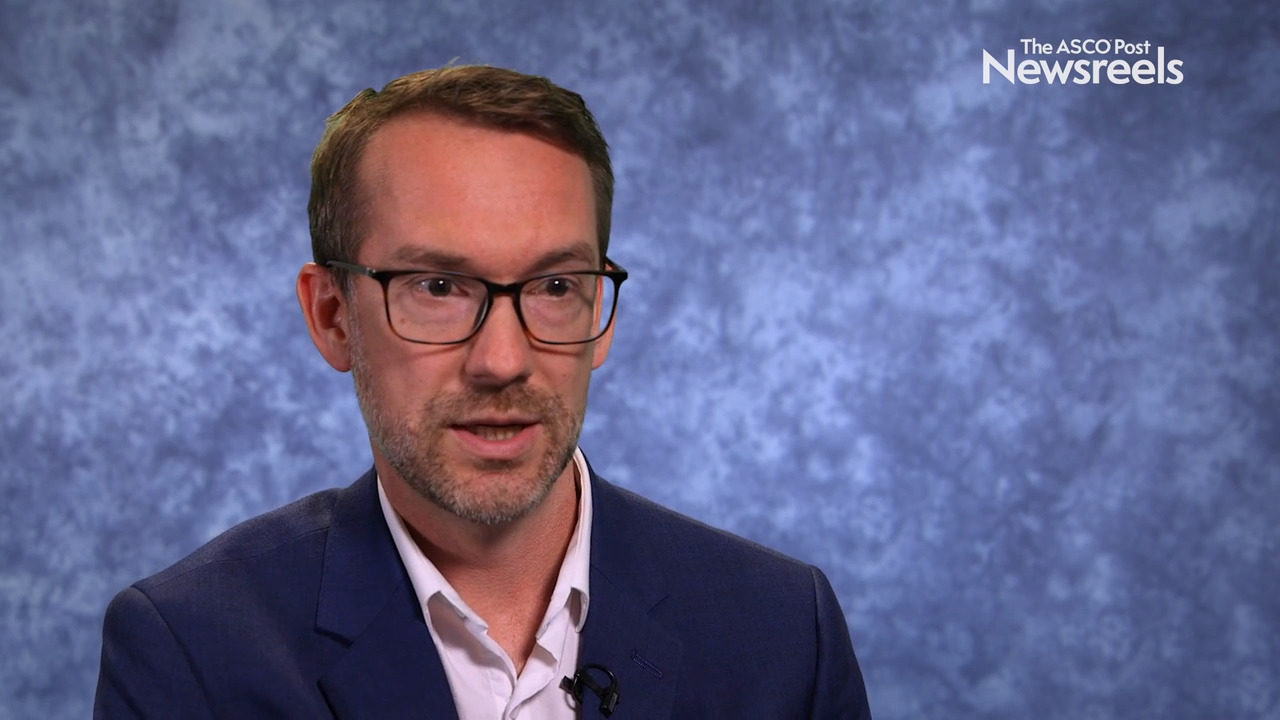Effect of Embedding a Palliative Care Nurse Practitioner in an Oncology Clinic
In a single-center study reported in JCO Oncology Practice, D’Ambruoso et al found that their Integrated Palliative Care and Oncology Program, which included the embedding of a palliative care nurse practitioner (PC-NP) in an oncology clinic, resulted in marked improvements in aspects of palliative ...
Risks and Benefits Associated With Gastrostomy Tubes for Patients With Cancer
In a study published by Gauvin et al in JNCCN–Journal of the National Comprehensive Cancer Network, researchers examined over 200 patients with gastrostomy tubes and highlighted the need for a multidisciplinary approach to palliative care decision-making for patients with cancer. A gastrostomy tube ...
Divya Gupta, MD, on Improving Advance Care Planning Conversations With Patients
Divya Gupta, MD, of the Stanford Cancer Center, discusses an intervention utilizing a computer model and lay care coaches to improve advance care planning conversations with patients who have metastatic cancer. The study, Dr. Gupta reports, showed a trend toward less intensive care for patients at the end of life.
Disparities in Terminal Hospitalization Among Adults With Metastatic Cancer
In a retrospective population-based study reported in JAMA Network Open, Deeb et al found that patients with metastatic cancer from racial and ethnic minority groups and those without private insurance were more likely to be admitted from the emergency department, receive invasive mechanical...
Improving End-of-Life Discussions With Patients Who Have Advanced Cancer
Although studies have shown that patients with advanced cancer want their oncologists to discuss their advance care plans with them, fewer than half of those patients have that conversation. The reasons are many, including the difficulty many oncologists have in initiating conversations about...
How COVID-19 Is Spotlighting the Role of Palliative Medicine
The COVID-19 pandemic has exposed the tragedy of patients dying in isolation, separated from family and friends to limit infection in hospital settings. The process has altered the experience of serious illness for patients and their loved ones, including their ability to grieve, share important...
Trends in Opioid Prescriptions Among Patients With Cancer Near the End of Life
In a study reported in the Journal of Clinical Oncology, Enzinger et al found that the prescription of opioids for cancer pain dropped markedly in the recent past among patients with poor-prognosis disease near the end of life, with the frequency of pain-related emergency department visits...
Weekly Outpatient Palliative Care Interventions Among Patients With Head and Neck Cancer
Over 90% of patients with head and neck cancer receiving curative-intent chemoradiation therapy found weekly palliative care visits to be a valuable addition to their treatment, a recent study published by Bauman et al in the Journal of Palliative Medicine found. Although palliative care is known...
Bringing Palliative Care to Native American Patients With Cancer
Native Americans are among the most underserved minority populations in the United States and are disproportionately affected by cancer. They have the lowest survival rates for nearly all types of cancer of any minority population and much higher rates of certain types of cancer, including lung,...
Study Finds Need to Improve Knowledge About Palliative Care Among U.S. Adults
The use of palliative care in hospitals in the United States has steadily risen over the past decade, with almost universal access to services in large hospitals and academic medical centers. Despite this increased access and recommendations from ASCO that all patients with advanced cancer receive...
The Daughter of a Fighter Pilot Becomes a Leader in Compassionate Cancer Care
Jamie H. Von Roenn, MD, FASCO, grew up in the suburbs of Chicago as the middle child of three girls. She was, by her own account, extremely shy by nature. Her mother was a graduate of the University of Chicago, but her father’s college education was preempted by his service as a fighter pilot in...
Balancing a Reverence for Life With a Belief That Patients Have a Right to a Dignified Death
The U.S. right-to-die movement took root in the mid-1970s, when Derek Humphry helped his wife, who was dying of breast cancer, take her own life. Five years later, Mr. Humphry founded the Hemlock Society, the first right-to-die organization in the United States,1 and set off a firestorm of...
Machine Learning–Based Algorithm May Predict Short-Term Mortality in Patients With Cancer and Prompt Serious Illness Conversations
Although most patients with terminal cancer, 87%, have end-of-life conversations with clinicians about their goals and preferences for care, on average, these discussions happen just 1 month before death and most often occur in acute care settings with clinicians who are not their treating...
Expert Panel–Endorsed Quality Measures for End-of-Life Care for Children With Cancer
There is currently no consensus on what quality end-of-life care for children with cancer looks like, or how to measure and deliver it; however, investigators recently assembled an expert panel to help fill this void. In a study published by Emily Johnston, MD, MS, and colleagues in the journal...
End-of-Life Care Remains Aggressive for Patients With Ovarian Cancer
Patients with ovarian cancer frequently receive aggressive end-of-life care despite industry guidelines that emphasize quality of life for those with advanced disease, according to a recent study published by Mullins et al in the journal Cancer. In fact, by 2016, intensive care unit (ICU) stays and ...
Cancer-Related Suicide Has Declined in the United States Over the Past 2 Decades
Despite increases in overall suicide rates in the United States during the past 2 decades, cancer-related suicides declined by 2.8% per year in the same time period, according to a new study published by Han et al in JNCI: Journal of the National Cancer Institute. The study found that the largest...
Lena E. Winestone, MD, MSHP, on Health-Care Disparities in Hematologic Cancers: Real-World Data
Lena E. Winestone, MD, MSHP, of the University of California, San Francisco and Benioff Children’s Hospital, reviews different aspects of bias in treatment delivery, including patient selection for clinical trials; racial and ethnic disparities in survival for indolent non-Hodgkin diffuse large B-cell lymphomas; and end-of-life hospitalization of patients with multiple myeloma, as well as outcome disparities (Abstracts 207-212).
Integrated Palliative and Oncology Care for Patients Receiving Treatment for AML
In a study reported in JAMA Oncology, Areej El-Jawahri, MD, and colleagues found that integrated palliative and oncology care was associated with better quality of life vs usual care among patients receiving treatment for acute myeloid leukemia (AML). The investigators stated, “Patients with AML...
Reducing the Risk of Lymphedema in Patients With Cancer
Although the exact incidence of treatment-related lymphedema among cancer survivors is unknown—most likely due to its prolonged latency period—it can be a lifelong chronic side effect that negatively impacts survivors’ quality of life. Although the condition is often linked to treatment for breast...
End-of-Life Care Among Commercially Insured Women Younger Than 65 With Metastatic Breast Cancer
In a study reported in JCO Oncology Practice, Ferrario et al found a sizable increase in end-of-life intensive care unit (ICU) admissions and a small but significant increase in emergency department visits over time among commercially insured women younger than age 65 with metastatic breast cancer...
SBRT May Provide Superior Pain Relief From Spinal Metastases vs Conventional Radiotherapy
Stereotactic body radiation therapy (SBRT) was superior to conventional radiation therapy in reducing pain from spinal metastases in a phase II/III study reported by Arjun Sahgal, MD, and colleagues at the 2020 American Society for Radiation Oncology (ASTRO) Annual Meeting (Abstract LBA 2). More...
Behavioral Nudges Combined With Machine Learning Mortality Estimates May Improve Rate of Advanced Cancer Care Conversations
An electronic nudge to clinicians—triggered by an algorithm that used machine-learning methods to flag patients with cancer who would most benefit from a conversation around end-of-life goals—tripled the rate of those discussions, according to a new prospective, randomized study of nearly 15,000...
How Anxiety, Depression, and Low Social Support Impact the Intensity of Cancer Pain
Pain is one of the most common byproducts of cancer and its treatment. Tumors, surgery, intravenous chemotherapy, radiation therapy, targeted therapy, supportive care therapies (such as bisphosphonates), and diagnostic procedures can all cause pain in patients and may contribute to symptoms of...
Overcoming the Challenges of Improving Psychosocial Care for Patients With Cancer
Although the United States spends billions of dollars each year on cancer research, very little of that funding is dedicated to mental health research in patients with cancer, despite the fact that cancer survivors have a six-time higher risk for psychological disability than people without...
A Palliative Care Specialist Explores What It Means to Live and Die With Dignity and Purpose
Palliative care’s road to acceptance as standard-of-care practice has been a remarkably unsmooth one, given its core mission: improving the quality of life of patients and their families by relieving the pain, symptoms, and stress of a serious or life-limiting illness. A person’s relationship with...
Determining the Best Place to Die for Patients With Cancer
Studies have shown a disconnect between where patients say they want to die and where they actually die. According to research from Stanford School of Medicine, although an overwhelming majority of Americans—about 80%—would prefer to die at home, just 20% do. In fact, 60% die in acute care...
Effect of Functional Impairment on Hospitalized Patients With Cancer
New research published by Lage et al in JNCCN–Journal of the National Comprehensive Cancer Network found 40.2% of hospitalized patients with advanced, incurable cancer were functionally impaired at the time of admission—meaning they needed assistance with activities of daily living like walking,...
Prioritizing Patients With Metastatic Disease for Palliative Radiotherapy
In anticipation of how the COVID-19 pandemic might impact oncology care as the coronavirus spread across New York City, radiation oncologists with expertise in the management of metastatic disease and inpatient oncologic emergencies at Memorial Sloan Kettering Cancer Center (MSK) met in late winter ...
2020 GI Cancers Symposium: Does Receipt of Palliative Care Increase Survival in Patients With Metastatic Esophageal Cancer Declining Chemotherapy?
Patients with metastatic esophageal cancer who declined chemotherapy but received palliative care had a numerically higher, but not statistically significant, difference in overall survival. These findings will be presented by Manguso et al at the 2020 Gastrointestinal Cancers Symposium (Abstract...
Early Palliative Care for Patients With Hematologic Malignancies: Beneficial but Underused
The use of billed palliative care services among Medicare beneficiaries with hematologic malignancies has risen dramatically in recent years, but most encounters still occur within days of death, according to research presented at the 2019 Supportive Care in Oncology Symposium.1 The analysis of...
Palliative Care Bill Unanimously Approved by U.S. House of Representatives
On October 28, the U.S. House of Representatives unanimously approved the Palliative Care and Hospice Education and Training Act (PCHETA). The bipartisan bill would increase federal research funding for palliative care—including pain and symptom management—and would establish palliative care...
Expert Point of View: Paul B. Jacobsen, PhD, FASCO
Paul B. Jacobsen, PhD, FASCO, Associate Director of the National Cancer Institute’s Division of Cancer Control and Population Science’s Healthcare Delivery Research Program, said that this study exemplifies the type of work that is needed to more broadly and rapidly translate promising research...
Community Health Workers May Improve Value of End-of-Life Cancer Care
The results of simple interventions involving community health workers suggest that improvements in value-based cancer care need not come from health-care professionals. According to data presented at the 2019 ASCO Quality Care Symposium,1 reliance upon community health workers trained to assess...
Is Implicit Bias Contributing to Time Disparities in Goals-of-Care Conversations With Minority Patients?
GUEST EDITOR Addressing the evolving needs of cancer survivors at various stages of their illness and care, Palliative Care in Oncology is guest edited by Jamie H. Von Roenn, MD, FASCO. Dr. Von Roenn is ASCO’s Vice President of Education, Science, and Professional Development. It has been well...
Is Implicit Bias Contributing to Time Disparities in Goals-of-Care Conversations With Minority Patients?
GUEST EDITOR Addressing the evolving needs of cancer survivors at various stages of their illness and care, Palliative Care in Oncology is guest edited by Jamie H. Von Roenn, MD, FASCO. Dr. Von Roenn is ASCO’s Vice President of Education, Science, and Professional Development. It has been well...
Robert Olson, MD, on Quality-of-Life Outcomes After Stereotactic Ablative Radiotherapy vs Standard-of-Care Palliative Treatments
Robert Olson, MD, of the BC Cancer Centre for the North, discusses a secondary analysis of the SABR-COMET trial, which showed there was a small magnitude decline in quality of life in both arms of the study but no associated detriment with stereotactic ablative radiotherapy (Abstract 148).
How an Innovative AI-Based Smartphone Application Is Addressing Patients’ Palliative Care Needs
GUEST EDITOR Addressing the evolving needs of cancer survivors at various stages of their illness and care, Palliative Care in Oncology is guest edited by Jamie H. Von Roenn, MD, FASCO. Dr. Von Roenn is ASCO’s Vice President of Education, Science, and Professional Development. During the 2019...
Improve Quality of Life With This Palliative Care Education Resource for Your Patients
Do your patients know that supportive care can help them manage their symptoms and side effects, regardless of age, cancer type, or disease stage? Make sure your patients understand the benefits of palliative care and where to access services with the ASCO Answers Palliative Care booklet. Your...
2019 ASCO: Differences in End-of-Life Quality Measures Across U.S. Cancer Centers
In a study presented by Wasp et al at the 2019 ASCO Annual Meeting (Abstract 6507) studying variation in end-of-life care across cancer centers in the United States, researchers found quality of care was lower at centers that served a greater concentration of minorities. However, end-of-life care...
House Calls With Her Physician Father Sparked an Interest in Palliative Care for Janet L. Abrahm, MD
Nationally regarded palliative care expert Janet L. Abrahm, MD, was born and reared in San Francisco. Her father was a solo practitioner who saw medicine as a great profession. “My father would come home from his office for dinner and when he finished, he’d do house calls, often bringing us with...
Effect of Increased VA Hospice Care on Use of Aggressive Care and Costs for Veterans With Advanced Lung Cancer
In a study reported in JAMA Oncology, Mor et al found that veterans with advanced lung cancer treated in Veterans Affairs (VA) Medical Centers with high hospice use were more likely to receive concurrent cancer care but less likely to receive aggressive care. Moreover, veterans treated at...
Sweet Surrender
The ASCO Post is pleased to reproduce installments of the Art of Oncology as published previously in the Journal of Clinical Oncology. These articles focus on the experience of suffering from cancer or of caring for people diagnosed with cancer, and they include narratives, topical essays,...
National Consensus Project Clinical Practice Guidelines: Improving Education on the Tenets of Palliative Care
The provision of palliative care (primary or specialty) is paramount to providing excellent quality care to all patients with cancer. Palliative care is associated with improving the quality of life, mood, and survival in patients with cancer. In fact, ASCO guidelines recommend that patients with...
National Consensus Project Releases 4th Edition of Clinical Practice Guidelines for Quality Palliative Care
As reported by Betty R. Ferrell, PhD, MA, FAAN, FPCN, of the Division of Nursing Research and Education, City of Hope Medical Center, Duarte, California, and colleagues in the Journal of Palliative Medicine, the National Consensus Project (NCP) of the National Coalition for Hospice and Palliative ...
Innovative Research to Improve the Supportive Care Needs of Cancer Survivors
First launched in 2014, the Palliative Care in Oncology Symposium introduced a nascent interdisciplinary approach to the treatment of both the physical and psychological symptoms of cancer to improve disease outcome and quality of life for patients. Today, it has evolved into a leading forum for...
Site of Care May Affect Racial and Ethnic Minorities’ Access to Palliative Treatment
For patients at the end of life, palliative care can prolong survival and improve the quality of life for patients with a life-threatening illness and for their families—but studies have found that racial and ethnic minorities are less likely to receive end-of-life palliative care than...
Impact of Survival Predictions on Aggressive End-of-Life Care Among Patients With Metastatic Cancer
In a single-institution study reported in the Journal of Oncology Practice, Sborov et al found that inaccurate prediction of life expectancy can be associated with greater likelihood of aggressive end-of-life care among patients with metastatic cancer receiving palliative radiation therapy. Study...
Improving Palliative Care in Low-Resource Settings
In 2016, ASCO published an update to its Clinical Practice Guideline, “Integration of Palliative Care Into Standard Oncology Care,” which provides evidence-based recommendations for symptom management, clarification of treatment goals, support of coping and distress management, and coordination of...
The Great Opioid Debate: Treating Cancer Pain Safely
As the number of opioid-related deaths continues to rise in the United States, stakeholders are struggling to make sense of the crisis. At the 2018 Palliative and Supportive Care in Oncology Symposium, two experts in the field, Charles F. von Gunten, MD, PhD, and Leslie J. Blackhall, MD,...
Study Finds Poor Adherence to Guidelines in Preventing Chemotherapy-Induced Nausea and Vomiting
Adherence to antiemetic guidelines for the prevention of chemotherapy-induced nausea and vomiting has been shown to improve patient outcomes. However, a new study suggests that physicians are still struggling to reach attainable adherence targets in antiemetic prophylaxis.1 According to data...



